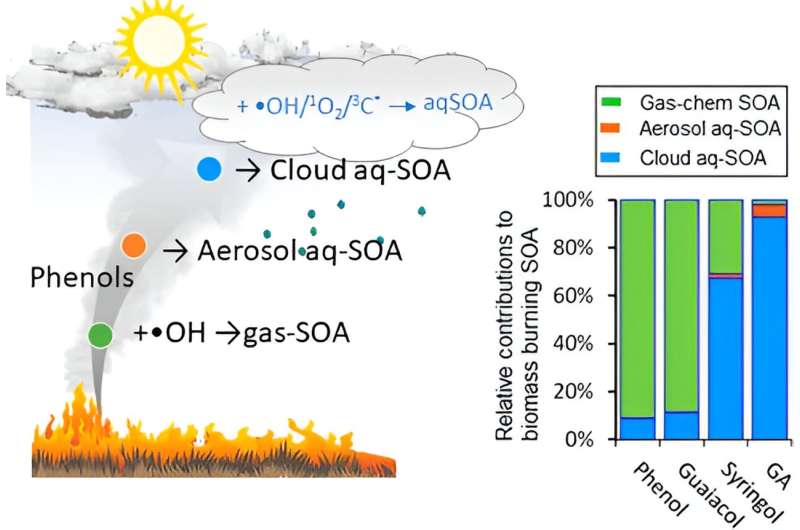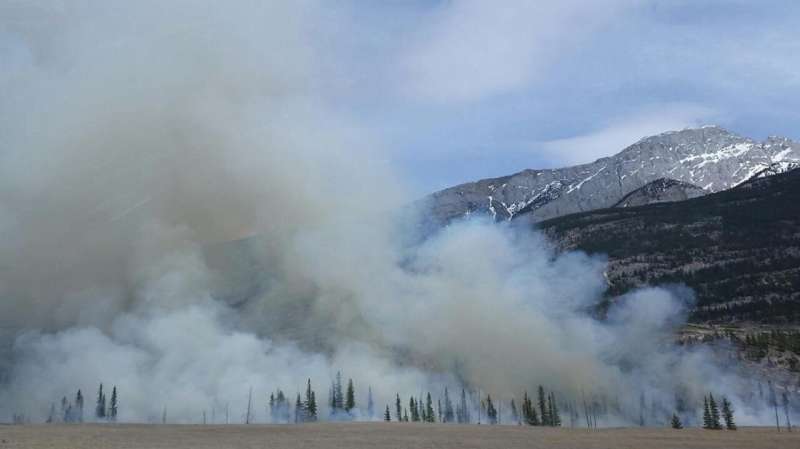This article has been reviewed according to Science X's editorial process and policies. Editors have highlighted the following attributes while ensuring the content's credibility:
fact-checked
peer-reviewed publication
trusted source
proofread
Study: Gases from burning biomass react within clouds, forming secondary organic aerosols

Thousands of tiny particles in the atmosphere unseen by the naked eye scatter and absorb solar radiation and become one of the bases for the formation of clouds. A lot of these particles are not directly emitted into the atmosphere from the land or ocean surface but are formed by reactions of gases with oxidants that are in multiple phases in the atmosphere, including the gas-phase, and in water that is in the liquid form in clouds and other particles.
Organic gases, such as phenols emitted in wildfires, could also be taken up into existing clouds, and they can then subsequently react with cloud water in the presence of sunlight to form secondary organic aerosols (SOA). However, a quantitative understanding of the chemistry of the formation of SOA in clouds is limited due to the complexity of their liquid-phase reactions and challenges in measurements.
A multi-institutional team of researchers has developed a stand-alone box model to predict aqueous and cloud chemistry of biomass-burning phenols based on laboratory measurements. They found that in cloudy environments, the cloud chemistry of soluble and reactive organic gases like phenols is likely a dominant source of biomass burning SOA, which is overlooked in climate models.
The study is published in Environmental Science & Technology.

Using mechanisms derived from laboratory measurements, the team of researchers simulated the multiphase chemistry of water-soluble organic gases emitted by biomass burning, and that includes their dissolution within aerosol and cloud liquid water followed by their aqueous-phase reactions to form SOA.
Within cloud layers, they found that highly soluble and reactive multifunctional phenols are almost entirely dissolved and react in cloud water, causing SOA formation that greatly exceeds their previously known formation due to gas-phase chemistry within these layers. Even near the surface in the absence of clouds, these highly soluble phenols form significant amounts of SOA in aqueous aerosols because they can be easily dissolved in aerosol liquid water and are available for aqueous aerosol chemistry.
The team's research is expected to open new frontiers in the understanding of how cloud chemistry increases SOA loadings in the atmosphere and its ability to seed clouds and to scatter and absorb the sun's radiation. In addition, this work will aid in the design of laboratory-based cloud chamber measurements that aim to understand how SOA cloud chemistry causes detectable changes in cloud droplet residuals and aerosols that serve as cloud condensation nuclei.
More information: Jie Zhang et al, Modeling Novel Aqueous Particle and Cloud Chemistry Processes of Biomass Burning Phenols and Their Potential to Form Secondary Organic Aerosols, Environmental Science & Technology (2024). DOI: 10.1021/acs.est.3c07762
Journal information: Environmental Science & Technology
Provided by Environmental Molecular Sciences Laboratory



















